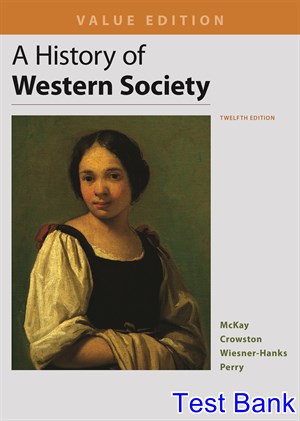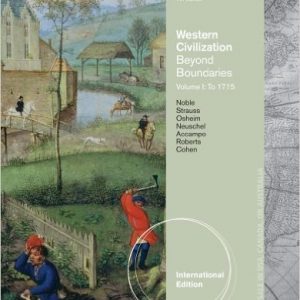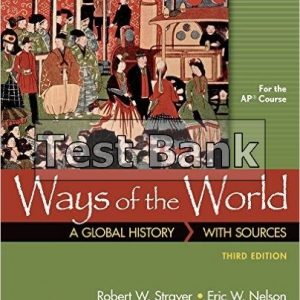Instant download History of Western Society Value Edition 12th Edition McKay Test Bank pdf docx epub after payment.

Product details:
- ISBN-10 : 1319031048
- ISBN-13 : 978-1319031046
- Author: John P. McKay; Clare Haru Crowston; Merry E. Wiesner-Hanks; Joe Perry
The past gets real and relevant as you hear the stories of ordinary people in History of Western Society, Value Edition, Combined. Successfully navigate the past by paying close attention to everyday life.
Table of contents:
The Combined Volume includes all chapters.
Volume 1 includes Chapters 1-16.
Volume 2 includes Chapters 14-30.
Preface
Maps and Figures
Special Features
Chapter 1: Origins, to 1200 B.C.E.
What do we mean by “the West” and “Western civilization”?
Describing the West
What Is Civilization?
How did early human societies create new technologies and cultural forms?
From the First Hominids to the Paleolithic Era
Domestication
Implications of Agriculture
Trade and Cross-Cultural Connections
What kind of civilization did the Sumerians build in Mesopotamia?
Environment and Mesopotamian Development
The Invention of Writing and the First Schools
Religion in Mesopotamia
Sumerian Politics and Society
How did the Akkadian and Old Babylonian empires develop in Mesopotamia?
The Akkadians and the Babylonians
Life Under Hammurabi
Cultural Exchange in the Fertile Crescent
How did the Egyptians establish a prosperous and long-lasting society?
The Nile and the God-King
Egyptian Religion
Egyptian Society and Work
Egyptian Family Life
The Hyksos and New Kingdom Revival
Conflict and Cooperation with the Hittites
LOOKING BACK / LOOKING AHEAD
Chapter 1 Review
Chapter 2: Small Kingdoms and Mighty Empires in the Near East, 1200–510 B.C.E.
How did iron technology shape new states after 1200 B.C.E.?
Iron Technology
The Decline of Egypt and the Emergence of Kush
The Rise of Phoenicia
How did the Hebrews create an enduring religious tradition?
The Hebrew State
The Jewish Religion
Hebrew Family and Society
How did the Assyrians and Neo-Babylonians gain and lose power?
Assyria’s Long Road to Power
Assyrian Rule and Culture
The Neo-Babylonian Empire
How did the Persians conquer and rule their extensive empire?
Consolidation of the Persian Empire
Persian Religion
Persian Art and Culture
LOOKING BACK / LOOKING AHEAD
Chapter 2 Review
Chapter 3: The Development of Greek Society and Culture, ca. 3000–338 B.C.E.
How did the geography of Greece shape its earliest kingdoms?
Geography and Settlement
The Minoans
The Mycenaeans
Homer, Hesiod, and the Epic
What was the role of the polis in Greek society?
Organization of the Polis
Governing Structures
Overseas Expansion
The Growth of Sparta
The Evolution of Athens
How did the wars of the classical period shape Greek history?
The Persian Wars
Growth of the Athenian Empire
The Peloponnesian War
The Struggle for Dominance
Philip II and Macedonian Supremacy
What ancient Greek ideas and ideals have had a lasting influence?
Athenian Arts in the Age of Pericles
Households and Work
Gender and Sexuality
Public and Personal Religion
The Flowering of Philosophy
LOOKING BACK / LOOKING AHEAD
Chapter 3 Review
Chapter 4: Life in the Hellenistic World, 338–30 B.C.E.
How and why did Alexander the Great create an empire, and how did it evolve?
Military Campaigns
The Political Legacy
How did Greek ideas and traditions spread to create a Hellenized society?
Urban Life
Greeks in Hellenistic Cities
Greeks and Non-Greeks
What characterized the Hellenistic economy?
Rural Life
Production of Goods
Commerce
How did religion, philosophy, and the arts reflect and shape Hellenistic life?
Religion and Magic
Hellenism and the Jews
Philosophy and the People
Art and Drama
How did science and medicine serve the needs of Hellenistic society?
Science
Medicine
Chapter 4 Review
Chapter 5: The Rise of Rome, ca. 1000–27 B.C.E.
How did the Romans become the dominant power in Italy?
The Geography of Italy
The Etruscans
The Founding of Rome
The Roman Conquest of Italy
What were the key institutions of the Roman Republic?
The Roman State
Social Conflict in Rome
How did the Romans build a Mediterranean empire?
The Punic Wars
Rome Turns East
How did expansion affect Roman society and culture?
Roman Families
New Social Customs and Greek Influence
Opposing Views: Cato the Elder and Scipio Aemilianus
What led to the fall of the Roman Republic?
The Countryside and Land Reforms
Political Violence
Civil War and the Rise of Julius Caesar
LOOKING BACK / LOOKING AHEAD
Chapter 5 Review
Chapter 6: The Roman Empire, 27 B.C.E.–284 C.E.
How did Augustus and Roman elites create a foundation for the Roman Empire?
Augustus and His Allies
Roman Expansion
Latin Literature
Marriage and Morality
How did the Roman state develop after Augustus?
The Julio-Claudians and the Flavians
The Nerva-Antonine Dynasty
What was life like in the city of Rome and in the provinces?
Life in Imperial Rome
Approaches to Urban Problems
Popular Entertainment
Prosperity in the Roman Provinces
Trade and Commerce
How did Christianity grow into a major religious movement?
Factors Behind the Rise of Christianity
The Life and Teachings of Jesus
The Spread of Christianity
The Growing Acceptance and Evolution of Christianity
What political and economic problems did Rome face in the third century C.E.?
Civil Wars and Military Commanders
Turmoil in Economic Life
LOOKING BACK / LOOKING AHEAD
Chapter 6 Review
Chapter 7: Late Antiquity, 250–600
How did Diocletian and Constantine try to reform the empire?
Political Measures
Economic Issues
The Acceptance of Christianity
How did the Christian Church become a major force in the Mediterranean and Europe?
The Church and Its Leaders
The Development of Christian Monasticism
Monastery Life
Christianity and Classical Culture
Christian Notions of Gender and Sexuality
Saint Augustine on Human Nature, Will, and Sin
What were the key characteristics of barbarian society?
Village and Family Life
Tribes and Hierarchies
Customary and Written Law
Celtic and Germanic Religion
How did the barbarian migrations shape Europe?
Celtic and Germanic People in Gaul and Britain
Visigoths and Huns
Germanic Kingdoms and the End of the Roman Empire
How did the church convert barbarian peoples to Christianity?
Missionaries’ Actions
The Process of Conversion
How did the Byzantine Empire preserve the legacy of Rome?
Sources of Byzantine Strength
The Law Code of Justinian
Byzantine Learning and Science
The Orthodox Church
LOOKING BACK / LOOKING AHEAD
Chapter 7 Review
Chapter 8: Europe in the Early Middle Ages, 600–1000
What were the origins of Islam, and what impact did it have on Europe as it spread?
The Culture of the Arabian Peninsula
The Prophet Muhammad
The Teachings and Expansion of Islam
Sunni and Shi’a Divisions
Life in Muslim Spain
Muslim-Christian Encounters
Cross-Cultural Influences in Science and Medicine
How did the Franks build and govern a European empire?
The Merovingians
The Rise of the Carolingians
The Warrior-Ruler Charlemagne
Carolingian Government and Society
The Imperial Coronation of Charlemagne
What were the significant intellectual and cultural developments in Charlemagne’s era?
The Carolingian Renaissance
Northumbrian Learning and Writing
How did the ninth-century invasions and migrations shape Europe?
Vikings in Western Europe
Slavs and Vikings in Eastern Europe
Magyars and Muslims
How and why did Europe become politically and economically decentralized in this period?
Decentralization and the Origins of “Feudalism”
Manorialism, Serfdom, and the Slave Trade
LOOKING BACK / LOOKING AHEAD
Chapter 8 Review
Chapter 9: State and Church in the High Middle Ages, 1000–1300
How did monarchs try to centralize political power?
England
France
Central Europe
Italy
The Iberian Peninsula
How did the administration of law evolve in this period?
Local Laws and Royal Courts
The Magna Carta
Law in Everyday Life
What were the political and social roles of nobles?
Origins and Status of the Nobility
Training, Marriage, and Inheritance
Power and Responsibility
How did the papacy reform the church, and what were the reactions to these efforts?
The Gregorian Reforms
Emperor Versus Pope
Criticism and Heresy
The Popes and Church Law
What roles did monks, nuns, and friars play in medieval society?
Monastic Revival
Life in Convents and Monasteries
The Friars
What were the causes, course, and consequences of the Crusades and the broader expansion of Christianity?
Background and Motives of the Crusades
The Course of the Crusades
Consequences of the Crusades
The Expansion of Christianity
Christendom
LOOKING BACK / LOOKING AHEAD
Chapter 9 Review
Chapter 10: Life in Villages and Cities of the High Middle Ages, 1000–1300
What was village life like in medieval Europe?
Serfdom and Social Mobility
The Manor
Work
Home Life
Childbirth and Childhood
How did religion shape everyday life in the High Middle Ages?
Christian Life in Medieval Villages
Saints and Sacraments
Muslims and Jews
Rituals of Marriage and Birth
Death and the Afterlife
What led to Europe’s economic growth and reurbanization?
The Rise of Towns
Merchant and Craft Guilds
The Revival of Long-Distance Trade
Business Procedures
The Commercial Revolution
What was life like in medieval cities?
City Life
Servants and the Poor
Popular Entertainment
How did universities serve the needs of medieval society?
Origins
Legal and Medical Training
Theology and Philosophy
University Students
How did literature and architecture express medieval values?
Vernacular Literature and Drama
Churches and Cathedrals
LOOKING BACK / LOOKING AHEAD
Chapter 10 Review
People also search:
History of Western Society Value Edition 12th Edition
History of Western Society Value Edition 12th Edition pdf
History of Western Society Value Edition
history of western society 13th edition
|
history of western society since 1300 |





